Newly discovered monkey is critically endangered by logging, poaching
mongabay.com
July 28, 2008
|
|
A newly discovered species of monkey may already be threatened with extinction, according to a study published in the journal Oryx.
A recent survey of the Southern Highlands and Udzungwa Mountains in Tanzania by the Wildlife Conservation Society (WCS) found that the kipunji — a primate discovered just three years ago — is limited to an area of only 6.82 square miles (17.69 sq km) of forest habitat. WCS estimates the population at 1,117 individuals.
“The kipunji is hanging on by the thinnest of threads,” said Dr. Tim Davenport, Tanzania Country Director for the Wildlife Conservation Society. “We must do all we can to safeguard this extremely rare and little understood species while there is still time.”
 The kipunji or Highland Mangabey. Photo by Dr Tim Davenport. |
Davenport and colleagues say the kipunji is threatened by poaching as a source of protein and habitat loss resulting from illegal logging and forest conversion. The authors propose listing the species as “critically endangered” under IUCN Red List criteria.
The kipunji, which stand about 3 feet (90 cm) tall, is known for its unusual call, termed a ‘honk-bark’ by the scientists who first described it. The species is so unique that it was classified in a new genus — the first new genus for a living monkey since Allen’s swamp monkey was described in 1923
More information about the kipunji can be found at kipunji.org.